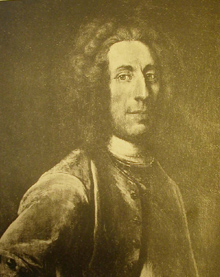Hugo Johan Hamilton
Hugo Johan Hamilton (* 1668 in Gothenburg , † January 9, 1748 in Tuna near Linköping , Sweden) was Baron zu Hageby, Swedish field marshal and general at the time of the Great Northern War .
Life
His parents were Malcolm Hamilton af Hageby and Katarina Makekéer. His father came from an Irish branch line of the Scottish aristocratic family Hamilton . In 1681 he was accepted into the Swedish Regiment Älvsborg with the rank of sergeant . However, he began his military career in the French army, with which he took part in the siege and conquest of the fortress of Namur and the battle of Steenkerke in 1692 . He then served in the Dutch army and took part in the Battle of Neerektiven (1693). Then Hugo Hamilton returned to Sweden and was in the army of Charles XII. recorded.
In the battle of Narva he fought with the rank of lieutenant colonel , in the battle of Klissow he was already a colonel . As part of the units under the command of General Carl Gustaf Rehnskiöld , he took part in the defense of Warsaw. In Poland, Hamilton fell seriously ill. He was forced to return to Sweden to recover there. However, he did not last long there: after a few months he returned to the fighting army and took part in the battle of Fraustadt (1706). In 1707 his wife Katarina Falkenberg made the decision to visit him abroad to show him his son, whom he had not yet seen. She did not survive this trip - she died unexpectedly in Szczecin . Despite this loss, Hamilton remained in the army. In 1708 he was in the Ukraine , where he commanded the East Gotha cavalry regiment with the rank of major general . He took part in the fighting at the Worskla in January 1709 and in the Battle of Poltava on June 27, 1709. He commanded the cavalry on the left flank of the Swedish army and was captured.
In July 1709 he was together with Berndt Otto von Stackelberg , Carl Gustav Rehnsköld, Carl Gustaf Creutz and some other high officers of Karl XII. brought to the fortress of Oranienburg, where he was until the beginning of winter. He was then taken to Moscow, where he was driven through the streets of Moscow on December 21, along with other prisoners of war Swedes. He was then detained in Moscow, where he, together with Count Carl Piper , worked in the Association of Swedish Prisoners of War in Russia. The association helped the captured soldiers of Charles XII. From 1715 the association was in Kazan . After the signing of the Nystädter Friedens (1721), Hamilton returned to Sweden in 1722. He thus spent more than 12 years in Russian captivity. After his return, with the rank of general , he was given command of the East Gotha cavalry regiment. He lived on his Tuna estate near the town of Linköping . In June 1723 he married Anna Fleming. In 1734 he was promoted to field marshal and in October 1742 he was appointed chairman of the highest military tribunal. This court investigated the wrong decisions of Charles Emil Lewenhaupt and Henrik Magnus Buddenbrock , which led to the encirclement of 17,000 Swedish soldiers near Helsinkfors (Helsinki). The verdict came in February 1743: the accused were beheaded, all awards were stripped of them and their property was confiscated. Hugo Hamilton died on January 9, 1748 on his Tuna estate. He was buried with his second wife Anna Fleming, who died in 1735, in the crypt of the church in Björklyng near Uppsala .
source
| personal data | |
|---|---|
| SURNAME | Hamilton, Hugo Johan |
| BRIEF DESCRIPTION | Swedish Field Marshal and General at the time of the Great Northern War |
| DATE OF BIRTH | 1668 |
| PLACE OF BIRTH | Gothenburg |
| DATE OF DEATH | January 9, 1748 |
| Place of death | Tuna near Linköping , Sweden |

